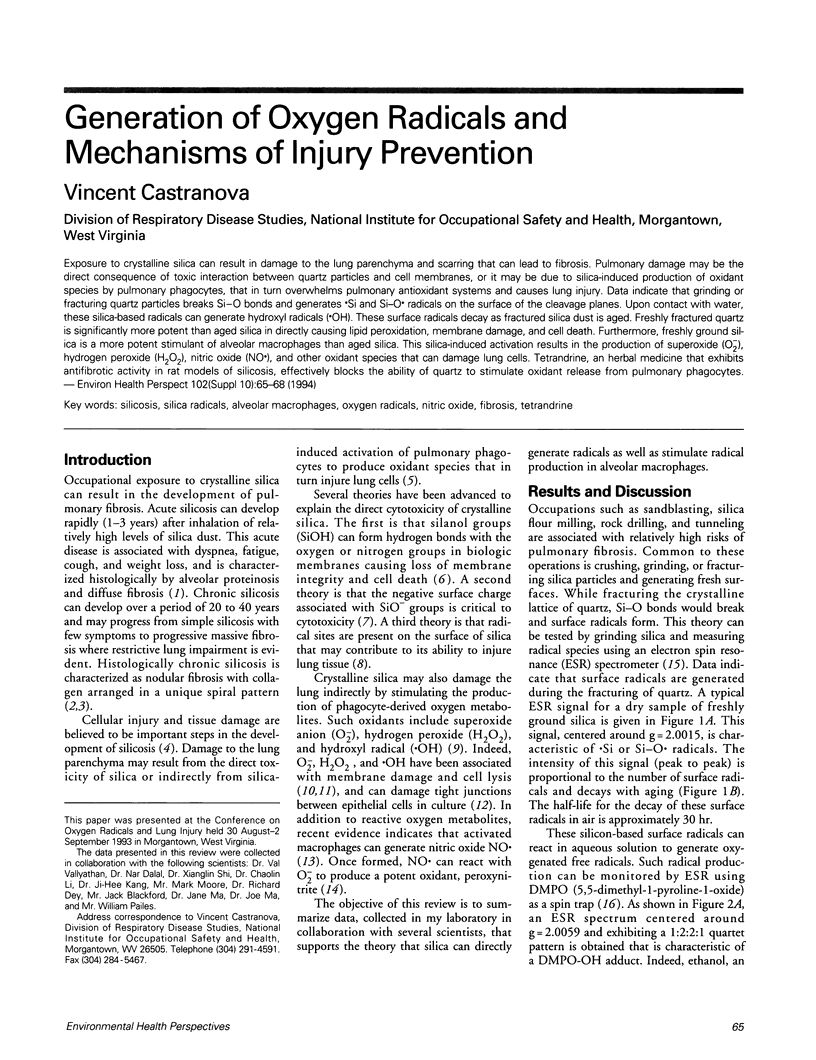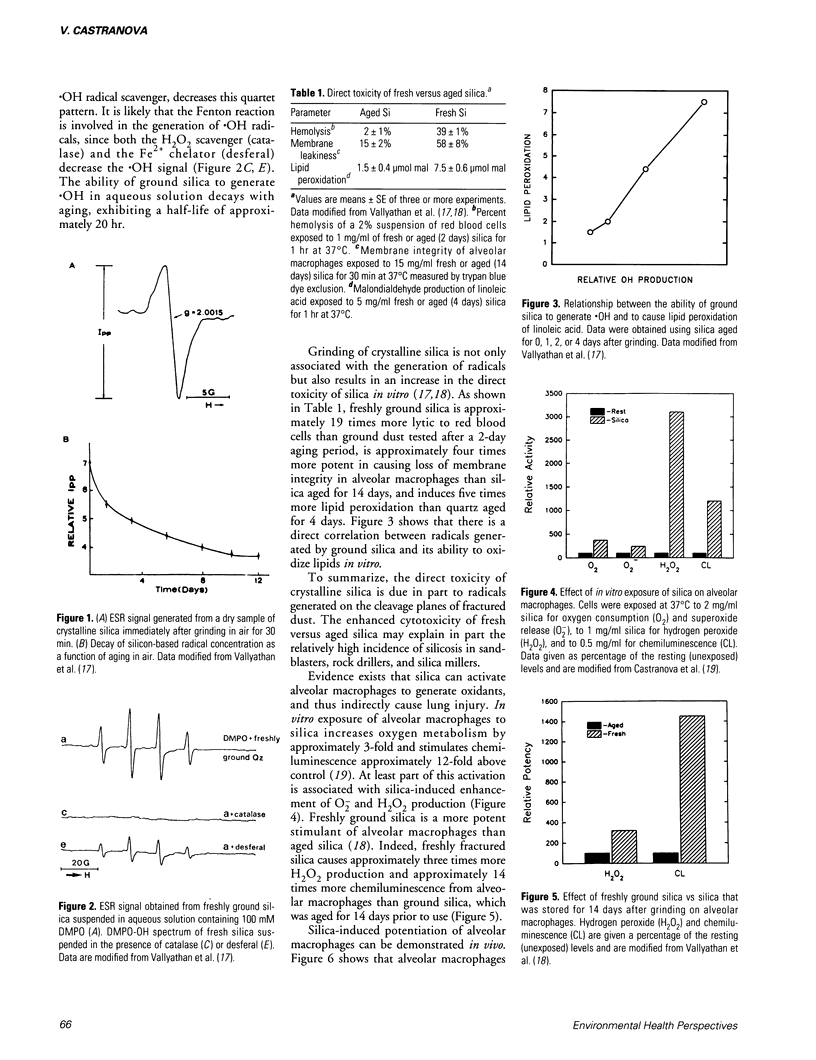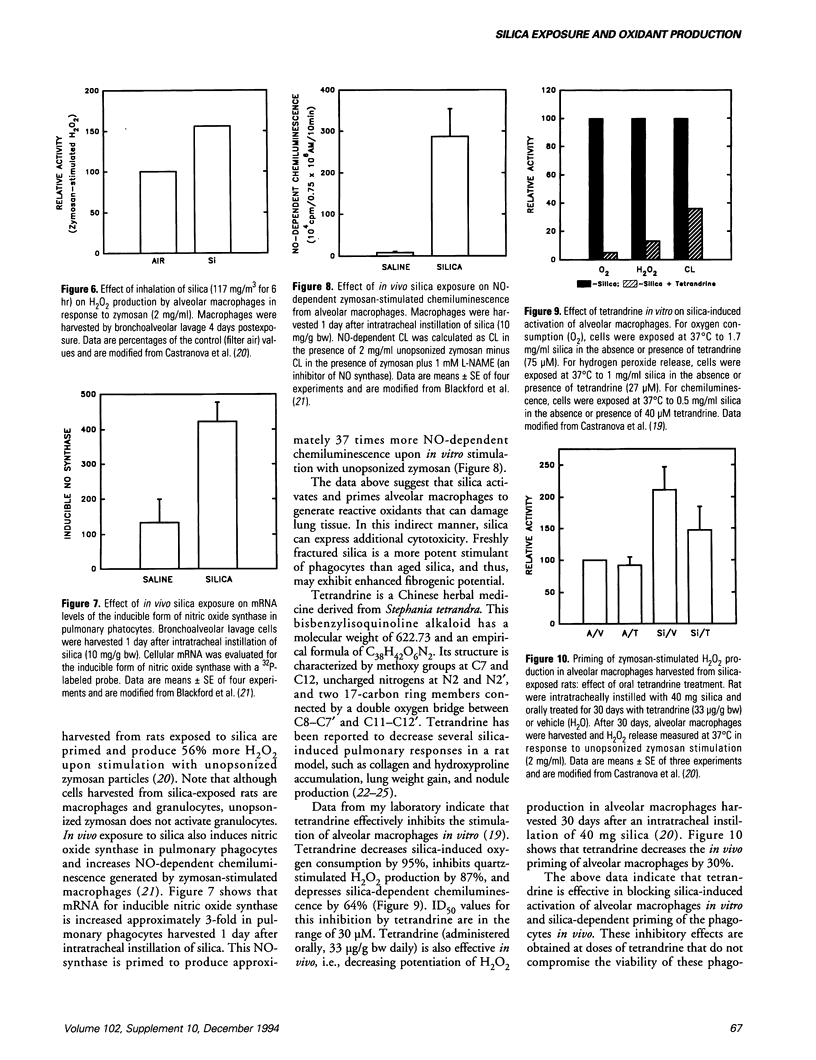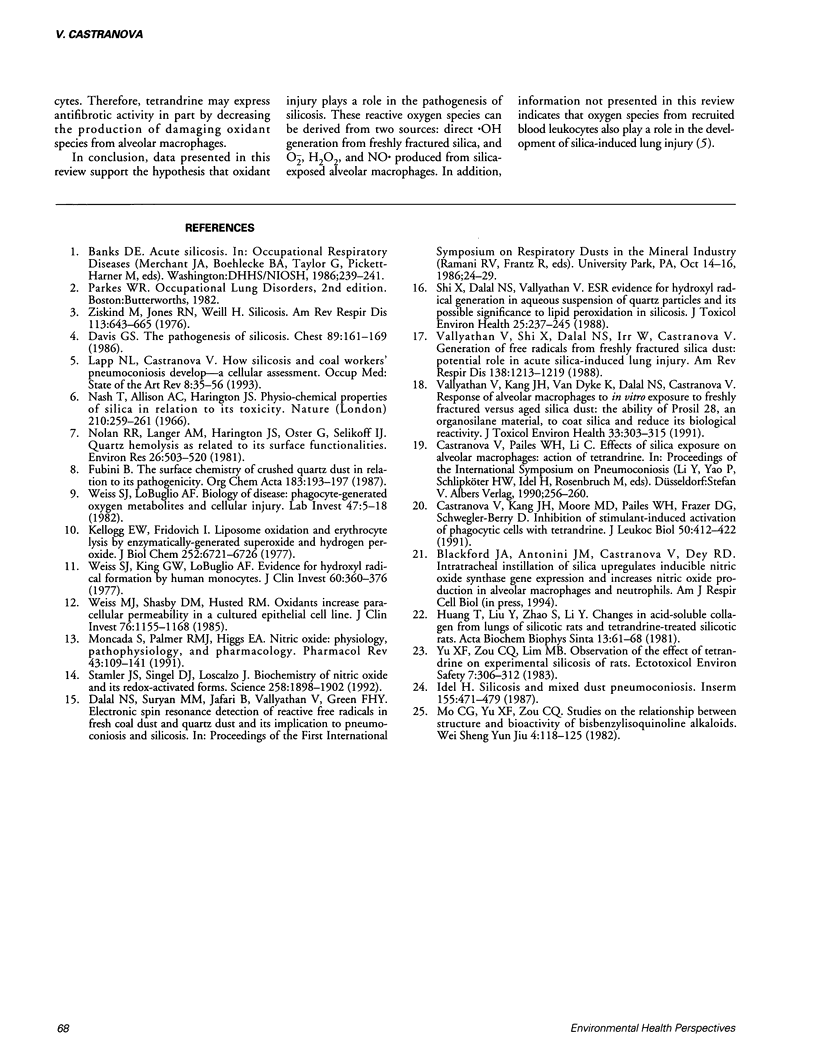Abstract
Exposure to crystalline silica can result in damage to the lung parenchyma and scarring that can lead to fibrosis. Pulmonary damage may be the direct consequence of toxic interaction between quartz particles and cell membranes, or it may be due to silica-induced production of oxidant species by pulmonary phagocytes, that in turn overwhelms pulmonary antioxidant systems and causes lung injury. Data indicate that grinding or fracturing quartz particles breaks Si-O bonds and generates .Si and Si-O. radicals on the surface of the cleavage planes. Upon contact with water, these silica-based radicals can generate hydroxyl radicals (.OH). These surface radicals decay as fractured silica dust is aged. Freshly fractured quartz is significantly more potent than aged silica in directly causing lipid peroxidation, membrane damage, and cell death. Furthermore, freshly ground silica is a more potent stimulant of alveolar macrophages than aged silica. This silica-induced activation results in the production of superoxide (O2-), hydrogen peroxide (H2O2), nitric oxide (NO.), and other oxidant species that can damage lung cells. Tetrandrine, an herbal medicine that exhibits antifibrotic activity in rat models of silicosis, effectively blocks the ability of quartz to stimulate oxidant release from pulmonary phagocytes.
Full text
PDF



Selected References
These references are in PubMed. This may not be the complete list of references from this article.
- Castranova V., Kang J. H., Moore M. D., Pailes W. H., Frazer D. G., Schwegler-Berry D. Inhibition of stimulant-induced activation of phagocytic cells with tetrandrine. J Leukoc Biol. 1991 Oct;50(4):412–422. doi: 10.1002/jlb.50.4.412. [DOI] [PubMed] [Google Scholar]
- Kellogg E. W., 3rd, Fridovich I. Liposome oxidation and erythrocyte lysis by enzymically generated superoxide and hydrogen peroxide. J Biol Chem. 1977 Oct 10;252(19):6721–6728. [PubMed] [Google Scholar]
- Lapp N. L., Castranova V. How silicosis and coal workers' pneumoconiosis develop--a cellular assessment. Occup Med. 1993 Jan-Mar;8(1):35–56. [PubMed] [Google Scholar]
- Lefcoe N. M. Passive smoking. Acute effects in asthma. Chest. 1986 Feb;89(2):161–162. doi: 10.1378/chest.89.2.161. [DOI] [PubMed] [Google Scholar]
- Moncada S., Palmer R. M., Higgs E. A. Nitric oxide: physiology, pathophysiology, and pharmacology. Pharmacol Rev. 1991 Jun;43(2):109–142. [PubMed] [Google Scholar]
- Nash T., Allison A. C., Harington J. S. Physico-chemical properties of silica in relation to its toxicity. Nature. 1966 Apr 16;210(5033):259–261. doi: 10.1038/210259a0. [DOI] [PubMed] [Google Scholar]
- Nolan R. P., Langer A. M., Harington J. S., Oster G., Selikoff I. J. Quartz hemolysis as related to its surface functionalities. Environ Res. 1981 Dec;26(2):503–520. doi: 10.1016/0013-9351(81)90226-7. [DOI] [PubMed] [Google Scholar]
- Shi X. L., Dalal N. S., Vallyathan V. ESR evidence for the hydroxyl radical formation in aqueous suspension of quartz particles and its possible significance to lipid peroxidation in silicosis. J Toxicol Environ Health. 1988;25(2):237–245. doi: 10.1080/15287398809531205. [DOI] [PubMed] [Google Scholar]
- Stamler J. S., Singel D. J., Loscalzo J. Biochemistry of nitric oxide and its redox-activated forms. Science. 1992 Dec 18;258(5090):1898–1902. doi: 10.1126/science.1281928. [DOI] [PubMed] [Google Scholar]
- Vallyathan V., Kang J. H., Van Dyke K., Dalal N. S., Castranova V. Response of alveolar macrophages to in vitro exposure to freshly fractured versus aged silica dust: the ability of Prosil 28, an organosilane material, to coat silica and reduce its biological reactivity. J Toxicol Environ Health. 1991 Jul;33(3):303–315. doi: 10.1080/15287399109531529. [DOI] [PubMed] [Google Scholar]
- Vallyathan V., Shi X. L., Dalal N. S., Irr W., Castranova V. Generation of free radicals from freshly fractured silica dust. Potential role in acute silica-induced lung injury. Am Rev Respir Dis. 1988 Nov;138(5):1213–1219. doi: 10.1164/ajrccm/138.5.1213. [DOI] [PubMed] [Google Scholar]
- Weiss S. J., LoBuglio A. F. Phagocyte-generated oxygen metabolites and cellular injury. Lab Invest. 1982 Jul;47(1):5–18. [PubMed] [Google Scholar]
- Welsh M. J., Shasby D. M., Husted R. M. Oxidants increase paracellular permeability in a cultured epithelial cell line. J Clin Invest. 1985 Sep;76(3):1155–1168. doi: 10.1172/JCI112071. [DOI] [PMC free article] [PubMed] [Google Scholar]
- Yu X. F., Zou C. Q., Lin M. B. Observation of the effect of tetrandrine on experimental silicosis of rats. Ecotoxicol Environ Saf. 1983 Jun;7(3):306–312. doi: 10.1016/0147-6513(83)90075-1. [DOI] [PubMed] [Google Scholar]
- Ziskind M., Jones R. N., Weill H. Silicosis. Am Rev Respir Dis. 1976 May;113(5):643–665. doi: 10.1164/arrd.1976.113.5.643. [DOI] [PubMed] [Google Scholar]


